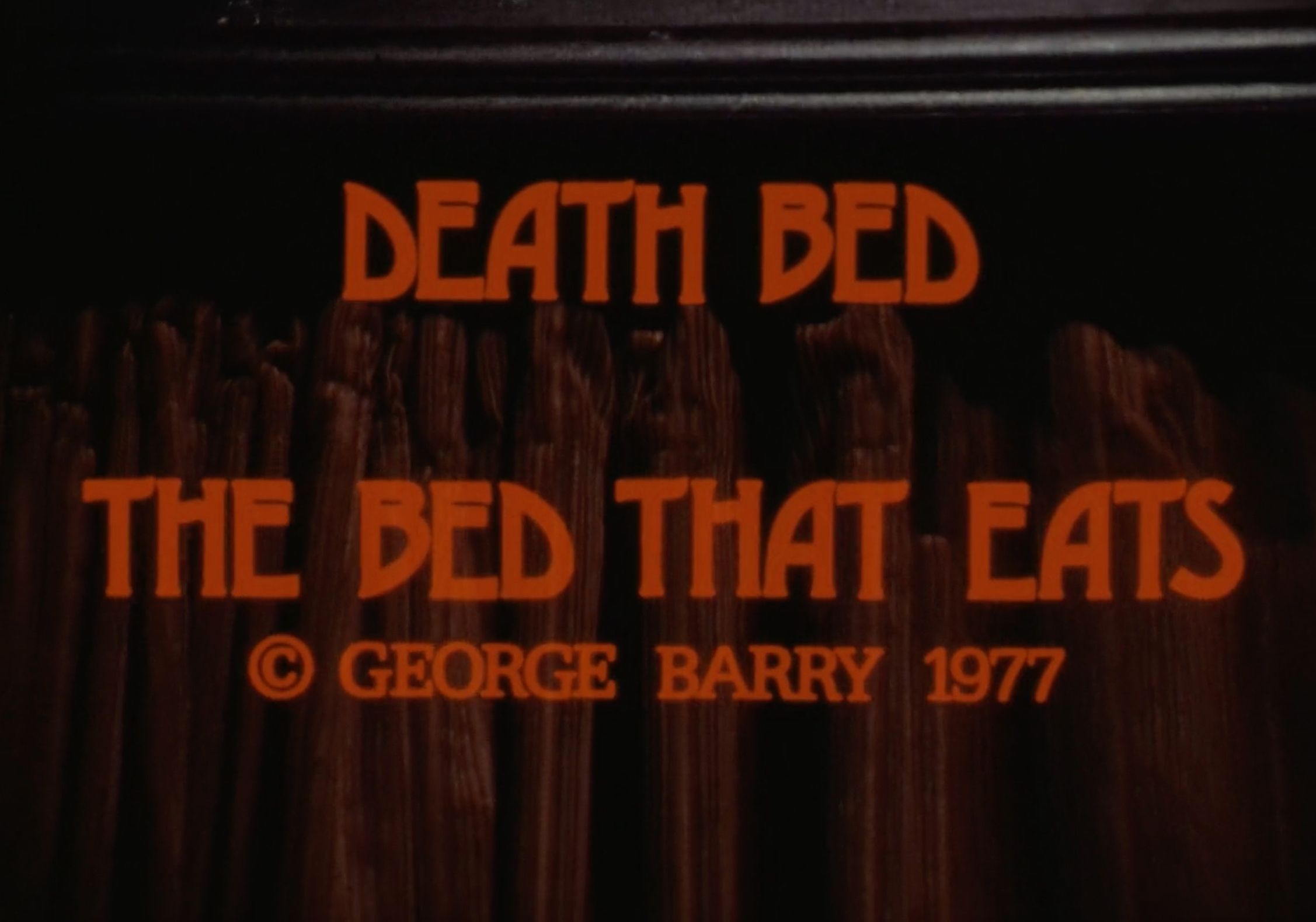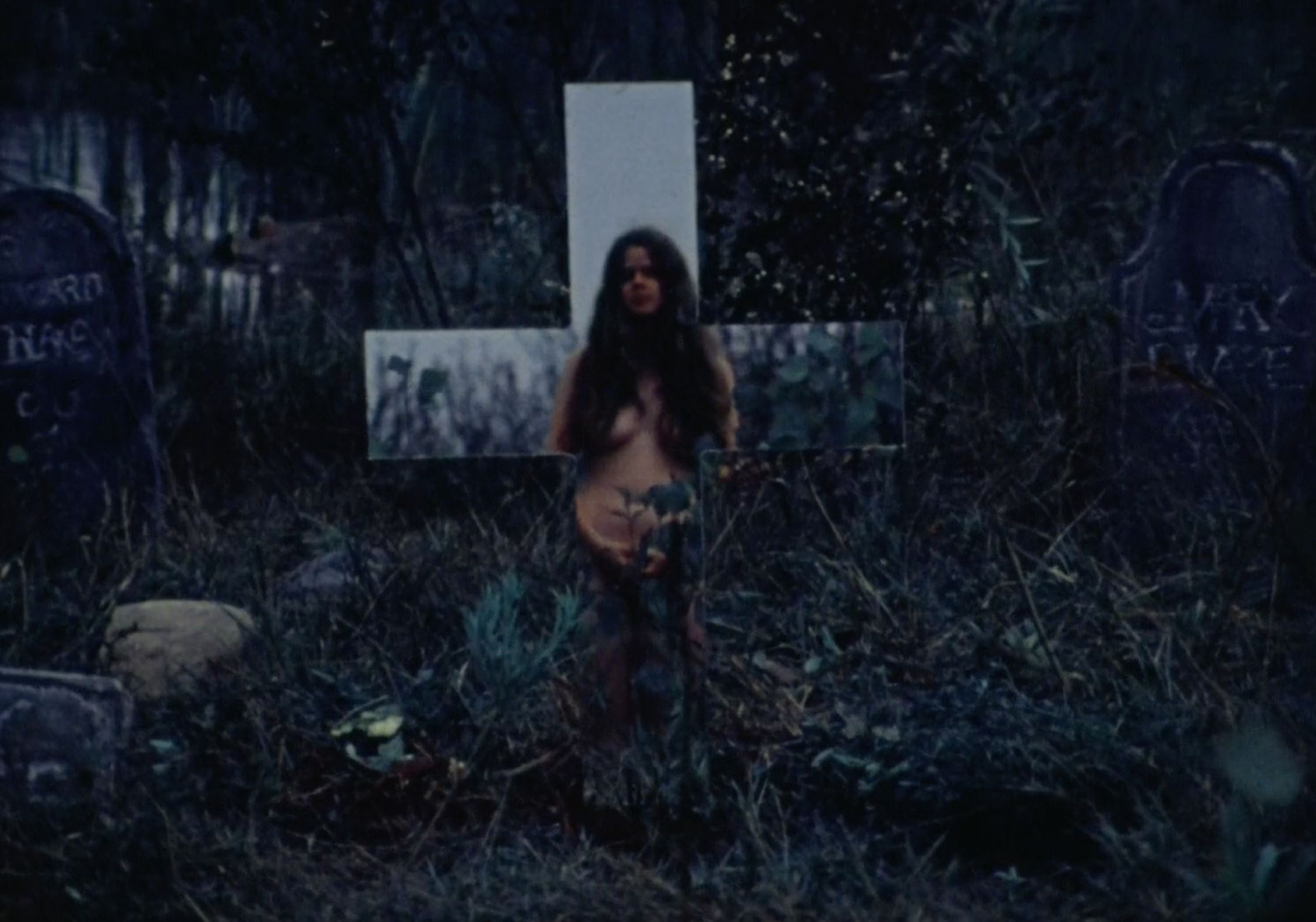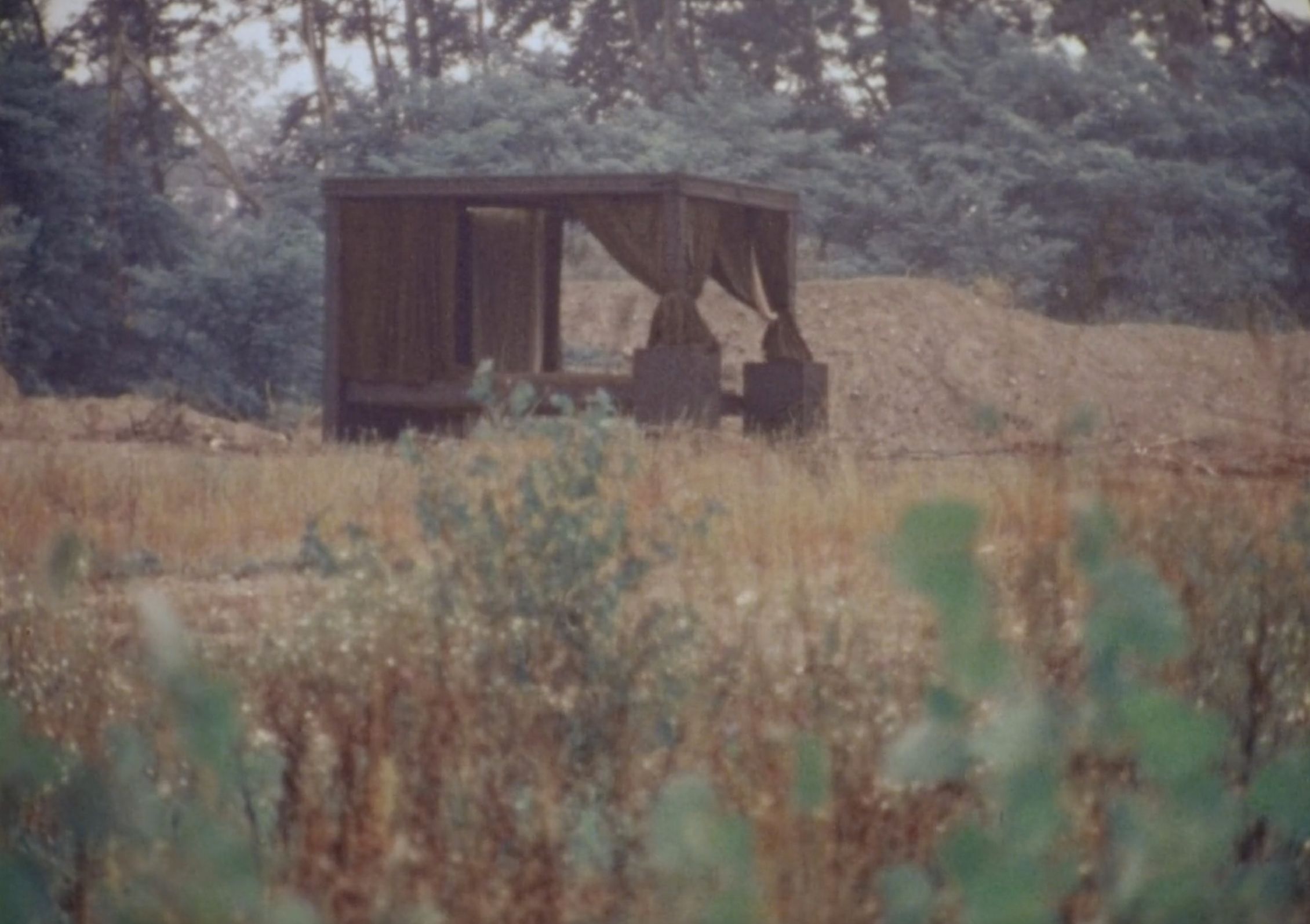 Inevitably, there are spoilers here, but I’ve tried to keep them to a minimum in the review half, enough that you could read it and still enjoy and be surprised by the film. However, by necessity, the game half spoils the film much more thoroughly. Read with care. Thanks!
Inevitably, there are spoilers here, but I’ve tried to keep them to a minimum in the review half, enough that you could read it and still enjoy and be surprised by the film. However, by necessity, the game half spoils the film much more thoroughly. Read with care. Thanks!
What is it? Death Bed: The Bed That Eats, written and directed by George Barry, and starring Patrick Spence-Thomas, Demene E. Hall, William Russ, and Julie Ritter.
First viewing? Yes.
 Pretty little demon eyes. Pretty little demon eyes. Pretty little pretty little pretty little…
Pretty little demon eyes. Pretty little demon eyes. Pretty little pretty little pretty little…
What’s it about? Hoo boy. So: In 1897, a red-eyed demon falls in love with a woman, but accidentally kills her when they have sex. (How, precisely, it isn’t stated, but presumably because he’s a demon.) Genuinely saddened, the demon cries tears of blood, which fall onto the bed he created just for their now-tragic boning session. This transforms an ordinary demon bed into a Death Bed, one that eats, consuming whatever lies on it. The bed, appearing to be one of those regular, non-demon, non-eating beds, is moved into the local mansion, where over the years it snacks on various residents and non-residents alike. Finally, in modern times (1977), the bed encounters a woman it can’t bring itself to eat: the spitting image of the demon’s deceased lover.
Oh, and it’s all narrated by an artist who, after being eaten by the bed, has become a ghost and is trapped inside one of his own paintings.
 This is the ghost of the artist, sitting “behind” his painting. It’s weird but also clever.
This is the ghost of the artist, sitting “behind” his painting. It’s weird but also clever.
What are your thoughts about it? Death Bed is the perfect inaugural film, because it represents the core of the Against the ’70s game project: there are no boundaries, anything goes, common sense and good taste need not apply.
Death Bed consistently breaks all the “rules” of good narrative. By the traditional definition of plot, this film has almost none: someone sits on the bed, gets eaten, another person sits on the bed, gets eaten, and so forth. In order to fill up the running time, writer/director George Barry throws everything into the pot to keep our attention: the aforementioned ghost narrator, who narrates flashbacks about the bed to fill in the time between the meals; voiceover to represent the thoughts of the characters; narratively unimportant dream sequences imagined by characters that are about to be bed chow; and a resolution that comes out of nowhere and is barely coherent.
Lest anyone be confused, this is all marvelous. It’s gripping, because we can never be sure exactly what’s going to happen, what we’re going to see. One moment might be a statue with bloody tears; then a character’s nightmare about eating a plate of bugs; then the improbable love-making between man and ghost. Barry makes the incredible choice to not only visualize the bed’s digestive process, but visualize it as if it were an Andres Serrano lab experiment. What’s more, the voiceover and the digressive flashbacks manage to reinsert character and depth into a structure that would normally preclude it. It’s suggested that one character had an abusive childhood, which may explain her neediness towards the other characters.
Since the premise precludes a “proper” narrative, Barry is free to let his imagination dictate the content and flow of images. The poetic quality of the film is strengthened by the Jean Rollin-esque countryside — we get some glimpses of “normal” life outside of the mansion, the seperate guest room, and the grounds, but not much. The effect is watching a wrested-from-the-subconscious fairy tale bleed into a contemporary world that not only has no place for fairy tales, but can’t really understand them. When one character stares at his, uh, injured hands (I’m trying to keep spoilers to a minimum), this clash is felt most strongly. What’s happened to him is impossible, but nonetheless, it’s real.
(I should note that the film isn’t without humor; in fact, it’s often quite funny, and there’s one shot, that I won’t spoil, that shows Barry’s in on the joke.)
Death Bed: The Bed That Eats is sui generis, an experimental film wrapped in a blanket of surrealism and tucked under the covers of a nightmare. It’s a beautiful gift to cinema, and a jewel of ’70s genre filmmaking.
 Only demon lovers left alive.
Only demon lovers left alive.
How many stars out of five? Four and a half.
Where can I stream it? As of this writing1, you can watch it for free on Kanopy, Tubi, and Pluto TV, or rent or buy it from Amazon Video or Alamo on Demand.
What can we take from it? The most obvious thing to take from Death Bed is the Bed itself, a unique monster in the annals of film history. However, this presents some problems, both for and against any players that take on this comfy creature. In the players’ favor: it doesn’t move. It’s still just a bed. It’s not going to dodge attacks or anything. Characters that wish to harm the bed or otherwise physically interact with it should be able to do so without penalty. However, the Death Bed, as presented in the movie, is indestructible, save for one specific weakness. Therefore, any characters that get close to it are almost inevitably going to be digested horribly.
That said, there are workarounds. As seen in the movie, the bed doesn’t always instantly try to devour anyone on it. Sometimes that’s because it feels like it can’t (such as the case with the woman who looks like the demon’s lover), and sometimes it waits until a victim is alone and can’t be rescued. At the same time, it’s a demon bed, so perhaps it needs no rational reason to do or not do something. Characters that lie on the bed (presumably unaware of its true nature) might be subject to visions, dreams or nightmares. These could be hints or clues of a deeper mystery within the scenario, or could simply be terrors inflicted on the character, causing Intellect damage.
However, going strictly by the source material, the Death Bed can be destroyed only one way: through a complex ritual that is only known by the Artist. I won’t go into the details; needless to say, it involves things that are probably not going to fly at the game table. I’ve provided some ideas of how this ritual could play in the “Special” section below, but the point is that it should be a difficult undertaking. If you want “just a monster,” then you may want take away its indestructibility (and maybe let it move and talk while you’re at it.) However, Cypher System characters are pretty tough and resourceful, even at Tier 1, and giving them a demanding series of tasks to perform should be in their wheelhouse.
The purpose of the game material in these posts is to take something from the movie and accurately transcribe it into game statistics. That said, feel free to change the Death Bed into something more suitable for your campaign.
 DEATH BED, THE BED THAT EATS (CREATURE)
DEATH BED, THE BED THAT EATS (CREATURE)
Level: 6 (Most physical attacks against it automatically hit, otherwise 18+ on a d20 to hit it; 18+ to avoid being hit.)
Description: A four-poster king-sized bed, made of oak. The Bed has a tester on top, with a double set of curtains, one white and lacy, one red velvet, that are set on rails and can be drawn closed. The thick headboard has an inscrutable, possibly occult, symbol carved into it.
Motive: Insatiable for food, whether that’s people, wine, or fried chicken.
Environment: An old, sparsely-furnished brick guest house on the grounds of a hundred year old mansion, located in a forest miles outside of town.
Health: 18, but immune to all damage, save one source. (see “Special” below)
Damage Inflicted: 10, or 10 Intellect if attacking through dreams.
Movement: The bed cannot move the frame; it must stay wherever it is. However, it can open and close the curtains, and it can use its sheets like a tentacle in order to ensnare prey within immediate range.
Combat: The typical way the Death Bed attacks is to absorb a victim that is on the mattress. If the Death Bed attacks and succeeds, the victim has fallen halfway into the bed’s digestive juices and takes 10 damage. Anyone on the mattress who is unaware of the Bed’s nature is hindered, as they are caught by surprise. If a victim has fallen halfway into the bed and is still alive, any Speed task to escape the Bed is hindered. The Death Bed can also shoot out a tentacle made of sheets to grab prey and pull it underneath the Bed. Anyone attacked in this way must make a Speed task roll, and failure means the character is ensnared. The character has 1-3 rounds to make a successful Might task roll before being pulled underneath the Bed. Characters underneath the Bed suffer 10 damage each round.
Interaction: The Death Bed cannot speak, but can communicate (after a fashion) to someone sleeping on it, via dreams and nightmares. Generally, though, the Death Bed is only interested in eating.
Special: Destroying the Death Bed requires a ritual that should be dangerous to perform and may require a sacrifice on part of the characters. The details are left to the GM, but should probably involve a magic circle drawn around the Bed, a similar magic circle outside, getting the Bed’s demon father to fall asleep, and the resurrection of the demon’s dead lover. If the ritual is successfully performed, the bed is teleported to the outside circle. There, it is it dealt 20 damage, causing it to explode and burn to cinders.
Use: For a hundred years, people have gone missing in the hills outside the city. The PCs investigate, centering on a mansion there that used to belong to a mobster. Clues and warnings in the mansion point to the rundown guest house at the edge of the property.
Loot: Although the Death Bed has no obvious loot in the movie, it makes sense that it might have some in a game. It’s possible that there could be a few cyphers among the remains of the destroyed Bed; it’s even possible that the remains are cyphers, or even an artifact.
GM Intrusion: The Death Bed regurgitates its yellow “stomach” acid, spraying everyone in immediate range and dealing 5 damage.
Originally published 11/5/21 on Substack
Next time on Against the ’70s: The Car (1977, Elliot Silverstein)
11/5/21↩︎